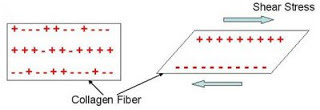Fascia Contracts
How does this happen? It’s because of the myofibroblasts, specialized fibroblast cells (they synthesize the  connective tissue matrix). Studies of myofibroblasts in mechanobiology prove that they are significant to wound healing/tissue injury and fibrosis. “Myo” means muscle, thus their contractability.
connective tissue matrix). Studies of myofibroblasts in mechanobiology prove that they are significant to wound healing/tissue injury and fibrosis. “Myo” means muscle, thus their contractability.
They have an important role in wound healing (a really good thing). But they are also responsible for fibrosis (not such a good thing).
The thing that is important for us in understanding therapeutically what they are and what they do, is to note the fibrotic, rigid tissue, which does NOT need more stimulation. Fibrotic, rigid and often inflamed tissue is already contracting and overactive!
Fibrotic tissue (low back pain sufferers being a good example) with either overactive myofibroblasts or high density of myofibroblasts really requires less aggressive stimulation; it requires regulation achieved through intermittent soft tissue ‘stretch/stress’, at just the right dose. This has now been proved scientifically.
Well, Bowen Therapy seems to give just the right dose.


